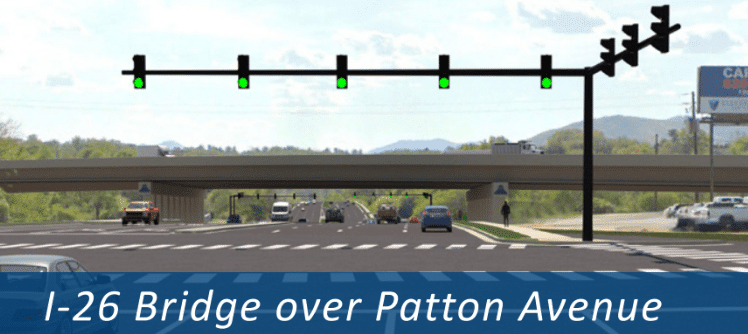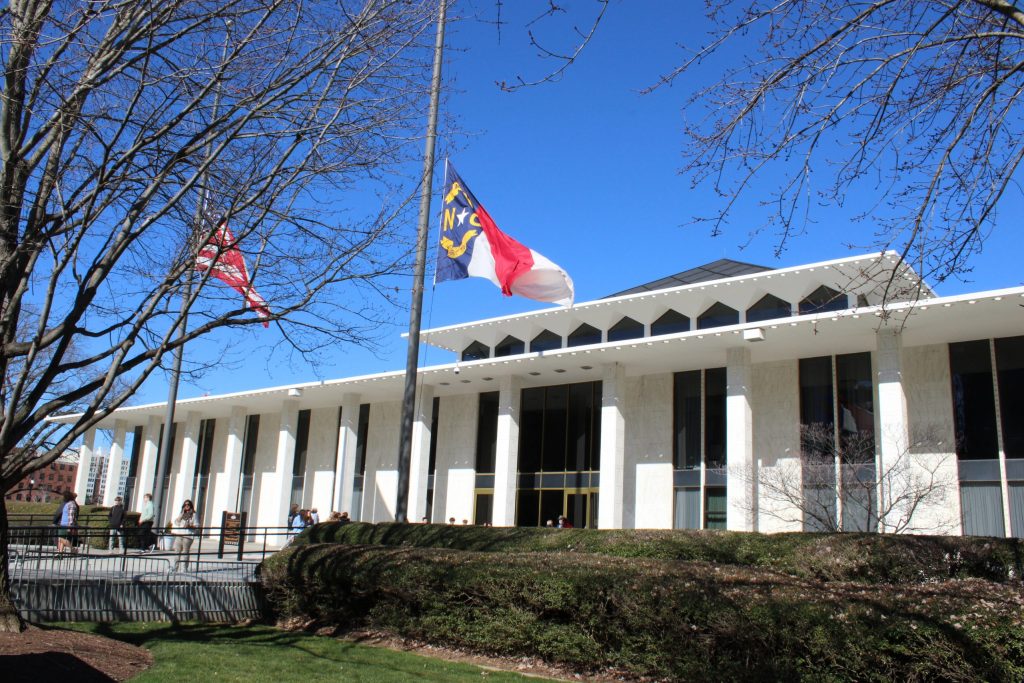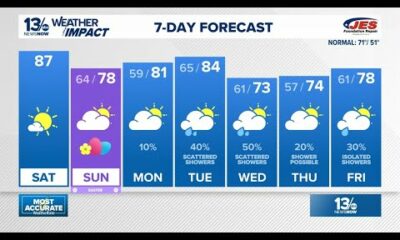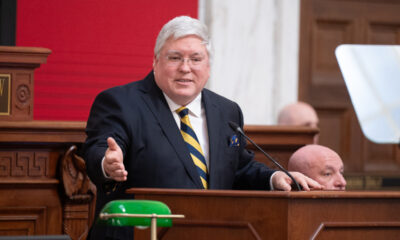News from the South - North Carolina News Feed
City officials attended meetings where NCDOT revealed I-26 flyover plan • Asheville Watchdog

High-ranking Asheville officials, including two assistant city managers and at least one City Council member, likely knew as early as last spring about the state’s decision to revive plans for a controversial overpass above Patton Avenue as part of the I-26 Connector project, according to meeting records obtained by Asheville Watchdog and interviews with people who attended those meetings.
But several Asheville City Council members said they and the public were left in the dark about the plan, despite more than a dozen discussions the North Carolina Department of Transportation held with staffers and other local stakeholders between early 2024 and January 2025.
They learned about it only after a presentation from the NCDOT at a Feb. 11 City Council meeting. Renderings shown during the meeting subtly revealed that the overpass had returned to the plans, which previously called for I-26 to run under Patton.
State Sen. Julie Mayfield, D-Buncombe, and French Broad River Metropolitan Planning Organization Director Tristan Winkler each said in interviews that they recalled the NCDOT referencing the overpass in meetings they attended last year.
Each attended three meetings last spring and summer, according to information the city provided in response to a Watchdog request. Others in attendance included assistant city managers Rachel Wood and Ben Woody; Jessica Morriss, the city’s assistant director of transportation; and City Council member Maggie Ullman.
“I-26 is needed to reduce traffic and improve quality of life for the community,” Ullman said via text message. “In my advocacy for improved transportation, DOT has explained (cost) cutting is needed for this project to move forward. I’m glad other key elements the community advocated for remain intact, but (I) am disappointed such a major decision was made unilaterally by the DOT.”

Ullman did not answer questions about her knowledge of the flyover plan and why, if she had information about it, she didn’t share it with other Council members or the public.
The Watchdog reached out to Wood and Woody for comment but did not receive responses.
The city has no agendas or minutes for those meetings, spokesperson Kim Miller said. According to a statement Miller provided from the city’s transportation department, city officials learned about the overpass design after the NCDOT selected a bidder, Archer-Wright Joint Venture, and began its “optimization and refinement” process to find ways to further cut costs.
Though Archer-Wright was publicly announced as the winning bidder on May 15, city records show the first optimization and refinement meeting took place 12 days earlier, with Ullman, Wood, Woody, and Morriss all in attendance.
‘I was not contacted’: Council members respond
Several Council members said they were blindsided by news of the flyover.
“I’m alarmed we are seeing a different plan move forward that was previously eliminated,” Council Member Sage Turner said. “The update came to Council as a presentation under the City Manager’s report with little notice and no details on this enormous change.”

The NCDOT made a presentation to council at its Feb. 11 meeting that briefly showed the eight-lane I-26 overpass on Patton Avenue, but city and state officials did not comment on it until The Watchdog first reported on the change on Feb. 14. The flyover design was dropped after it generated a backlash among city and county officials and stakeholders in 2008, with plans shifting to a design that carried I-26 beneath Patton Avenue near the Capt. Jeff Bowen bridge on the west side of the French Broad River.
“If they wanted or needed Council’s input as they made these big changes, they didn’t follow any procedures to do so,” Turner said via text message. “I was not contacted. Nor was I asked to vote on or support the changes. And while it’s great NCDOT has been able to eliminate large retaining walls and implement significant cost savings, why were these cost saving measures not on the table before? Will they return in a couple years with more changes after materials have gone up another 30 percent? Where’s the accountability to community, process, and budgets?”
In a Facebook post last week, Council Member Kim Roney, a multimodal transportation advocate, expressed frustration and noted that “some Council members and regional electeds were invited to review the design including flyover change last summer.” She wrote that she’s asked to be invited to all such meetings in the future. Roney did not respond to requests for comment.
Asheville Mayor Esther Manheimer offered praise to the NCDOT for pedestrian- and resident-friendly elements that remained in the plan, but she, too, said her first notification of the flyover bridge came in the Feb. 11 council meeting.

“While I am disappointed in the NCDOT’s reinstatement of the Patton Avenue flyover bridge, which council learned about at the last council meeting when DOT presented council with the revisions to the project, I am glad that many of the elements that Asheville fought for remain in the project such as the reduced footprint, the additional protections for Burton Street and Montford, bike and pedestrian infrastructure connecting West Asheville to downtown, and the aesthetic features recommended by the Aesthetics Committee,” Manheimer said in an emailed statement.
Council members Antanette Mosley, Sheneika Smith, and Bo Hess — the latter of whom joined council in December — did not respond to multiple requests for comment.
“While the City understands community concerns regarding the Patton Avenue/I-26 flyover design change, the NCDOT has committed to continuing to work with the City on the bridge’s design and aesthetic components,” the city said in its statement. “NCDOT is currently working to develop visual illustrations of the design change and plans to hold a public information session in the coming weeks.”
Chris Cooper, a political scientist at Western Carolina University, said the manner in which the flyover plan became public seems opaque.
“At the very least, I’d say this is not a good look for the city,” Cooper said. “This has been perhaps the most prominent transportation issue — not just in the city of Asheville, but in western North Carolina — for the last decade, and for something that had been ruled out to be presented in the final plan doesn’t exactly scream transparency.”
Cooper said elected officials have a duty to keep the public informed, as “people don’t vote for the DOT.
That responsibility is crucial “especially on a project that will affect transportation patterns, development, housing, the environment,” Cooper said. “Almost every major issue that affects the city is going to be touched by this project.”
The idea for an overpass above Patton Avenue was first proposed in 2008, but the NCDOT nixed it after protests from the city, Buncombe County, and the Asheville Design Center, a nonprofit that worked on designs that would eventually be incorporated into the project.
They argued that a bridge over Patton would hamper the development of the street into a pedestrian- and cyclist-friendly gateway between West Asheville and downtown. When the Connector project went through a public hearing process in late 2018, it included designs calling for the interstate to run under Patton.
The revival of the flyover came in 2023, during a pre-bid process in which prospective contractors could ask the NCDOT for permission to make substantial design changes. The agency approved Archer-Wright’s request in July of that year. Though the NCDOT docked Archer-Wright points on the technical score it uses to evaluate proposals — it came in second of the three bidders — the agency said the cost savings of putting the interstate over Patton made Archer-Wright’s $1.15 billion pitch the cheapest.
Neither of the other bidders, Balfour Beatty Infrastructure and Flatiron-United-BDC Joint Venture, proposed a flyover. Neither responded to multiple requests for comment for this story.
Archer-Wright has not publicly commented on the flyover design, and it did not respond to questions from The Watchdog this week. But public records show that when the contractor first proposed the design change, it downplayed potential cost savings. It instead pitched the overpass as being easier and safer to build than an underpass — it would take four phases instead of nine, involve less disruption of utility lines, and require fewer temporary traffic pattern changes on Patton.
While the NCDOT would save on long-term maintenance with the flyover and on utilities costs, an Archer-Wright engineer wrote in 2023, “no significant changes are anticipated for infrastructure costs.” Under a heading titled “Construction Cost,” he wrote “unchanged.”
In the nine months since Archer-Wright won the bid, the NCDOT has not published the contractor’s proposal on its website. The Watchdog obtained it through a public records request. Earlier this month, the agency said it had delayed publication because it expected the proposal to change significantly during the cost-cutting process.
West Asheville resident Brooke Heaton, an activist and avid cyclist, said the reemergence of the flyover — and the lack of transparency about it — is “really deeply disheartening.”
Return of the flyover, lack of transparency ‘beyond disheartening’
“It’s certainly beyond disheartening, because my understanding was there was a lot of community outreach and input that has been taking place for years on this,” Heaton said. “And so to push back on that is, I think, a pretty big break of trust between the residents of Asheville and DOT.”
Heaton says he cycles downtown multiple times a week from West Asheville and was looking forward to Patton Avenue and the Jeff Bowen Bridge becoming more pedestrian- and bike-friendly.
“I don’t know that riding under an eight-lane interstate highway makes it any more pedestrian-friendly,” Heaton said. “So it’s not really the type of city I was looking forward to living in for the rest of my life, having that massive interstate fly over that point.”
Because the flyover proposal will save money on the total project cost, Heaton doubts the community will be able to change the NCDOT’s mind. Heaton also said he doubts that a lot of people are aware of the change, despite recent news coverage.
“I don’t really know that you’re going to see much of an uprising locally about this, just because I think a lot of people are going to feel pretty powerless to change that, considering how much they’re trying to save,” Heaton said. “I think it’s going to be a permanent change for the city for generations, and that’s something we’re going to have to live with.”
Asheville Watchdog is a nonprofit news team producing stories that matter to Asheville and Buncombe County. Jack Evans is an investigative reporter who previously worked at the Tampa Bay Times. You can reach him via email at jevans@avlwatchdog.org. John Boyle has been covering Asheville and surrounding communities since the 20th century. You can reach him at (828) 337-0941, or via email at jboyle@avlwatchdog.org. The Watchdog’s local reporting during this crisis is made possible by donations from the community. To show your support for this vital public service go to avlwatchdog.org/support-our-publication/.
Related
The post City officials attended meetings where NCDOT revealed I-26 flyover plan • Asheville Watchdog appeared first on avlwatchdog.org
News from the South - North Carolina News Feed
Trump says ‘Crimea will stay with Russia’ as he presses for deal to end war in Ukraine

SUMMARY: Trump declared that “Crimea will stay with Russia” while seeking negotiations to end the Ukraine war. His envoy, Steve Wickoff, is headed to Russia to meet President Putin amid escalating violence, including a drone strike that killed three people in Ukraine. Meanwhile, a senior Russian general was killed near Moscow in a bombing, although no one has claimed responsibility. Tensions rise as Ukraine’s President Zelensky refuses to accept the annexation of Crimea, emphasizing that it conflicts with Ukraine’s constitution. Both sides express the desire for peace, but differing views complicate potential compromises and ceasefire efforts.

Trump says ‘Crimea will stay with Russia’ as he presses for deal to end war in Ukraine.
Download the WRAL App: https://www.wral.com/download-wral-apps/5787234/
The Latest Weather: https://www.wral.com/weather/page/1010362/
News Tips:
Online – https://www.wral.com/report-it/
Email – assignmentdesk@wral.com
Subscribe to WRAL:
https://youtube.com/c/wral5
Follow WRAL:
Facebook: https://facebook.com/WRALTV
X: https://twitter.com/WRAL
IG: https://instagram.com/wral
About WRAL-TV:
WRAL is your Raleigh, North Carolina news source. Check out our videos for the latest news in Raleigh, local sports, Raleigh weather, and more at https://WRAL.com
#localnews #northcarolina
News from the South - North Carolina News Feed
Where does Asheville Tourists’ concessions money go? Will local schools be impacted by federal DEI mandates? • Asheville Watchdog

Today’s round of questions, my smart-aleck replies and the real answers:

Question: I want to know if I go to an Asheville Tourists baseball game and pay the full price for a ticket, and buy two beers and two hot dogs, what’s the total cost for that? And how much of that goes to the DeWine organization? How much goes to the city?
My answer: I’m pretty sure most baseball stadium food, including this proposed meal, comes with a personal defibrillator.
Real answer: As we’ve previously reported, the Asheville Tourists Baseball Club is owned by the DeWine Seeds Silver Dollar Baseball LLC, which is owned by the family of Ohio Gov. Mike DeWine. DeWine’s son Brian is the president of the team and the owner-operator with his wife, Kali.
It seems like whenever Gov. DeWine, a Republican, makes some news in Ohio, I get some questions about the local team here and where the money goes. As we reported in 2022, the governor “personally owns 32 percent of the team, according to records, but has no management role in the team.” Brian DeWine, a resident of Asheville since 2010, calls the Tourists ‘a local, family-owned business.’”
Now, about those dogs and brews. First, Brian DeWine tried to upsell the fan.

“Are you sure your reader doesn’t also want to wash that down with a deep-fried moon-pie? Or a churro sundae?” DeWine asked.
Tempting, but I think they were hoping to live at least until Sunday.
“A beer is going to be $8-$9 and $1 and $3 on Thirsty Thursday,” DeWine said. “Hotdogs are $3.75, except on Fridays when they are $1.”
Tickets start at $9.50 for kids, $10.50 for military and seniors and $11.50 for an adult, he added, noting that all prices include sales tax. So under normal conditions, it looks like you’d be dropping $35 to get in, scarf down two ‘dogs and two beers, and enjoy the game.
The Tourists run the complete food and beverage operation, so the city, which owns McCormick Field, does not reap any financial benefits from it.
“The city does not collect a portion of food and beverage sales during baseball games at McCormick; we do however collect an annual rent payment from the team,” Chris Corl, the city of Asheville’s director of community and regional entertainment facilities, said via email. “This year’s rent is lower than ‘normal’ due to disruptions related to the construction project.”
The 2025 season at McCormick Field is being played “under construction,” as DeWine previously told The Watchdog. Some areas of the ballpark will be closed to fans during certain parts of the season, as the stadium undergoes a $38.5 million renovation project to comply with dictates from Major League Baseball to upgrade locker rooms and other facilities.
Corl provided the city’s rental rates for McCormick Field for last year, this year and next year:
- 2024: $100,000
- 2025: $50,000
- 2026: $450,000
The Tourists had their home opener April 8, although it was a rainy affair. The team’s 132-game schedule this year features 66 home games, including matchups on July 4, Mother’s Day, Memorial Day Weekend, and Labor Day Weekend.

Question: I haven’t heard any communications from the Asheville City Schools superintendent or the Buncombe County Schools district on how they are handling the Trump administration’s attack on DEI (diversity, equity and inclusion). I know that the ACS central office does have a fulltime staff member committed to equity, but I have not heard anything about changes in its programming or staffing. Might make for an interesting article to reach out to the Districts to ask what they are doing to respond to Trump’s and the Department of Education’s blocking of funding for districts with DEI policies or programs.
My answer: They’re keeping mum? Really? That’s odd in this climate …
Real answer: Asheville City Schools Chief of Staff Kimberly Dechant answered on behalf of city schools.
“At this time, Asheville City Schools remains committed to its mission of fostering an inclusive and equitable environment for ALL students and staff,” Dechant said via email (emphasis on “ALL” was hers). “There have been no changes to our programming or staffing related to Diversity, Equity, and Inclusion.”
On April 3, the Trump administration’s Department of Education sent a “reminder” notice to school systems titled, “Reminder of Legal Obligations Undertaken in Exchange for Receiving Federal Financial Assistance and Request for Certification under Title VI and SFFA v. Harvard.”
The court reference refers to the 2023 U.S. Supreme Court ruling in Students for Fair Admissions v. Harvard University and UNC Chapel Hill, which essentially banned consideration of race in college admissions.
The reminder notice sent to schools further states: “Title VI of the Civil Rights Act of 1964 provides that ‘no person in the United States shall, on the ground of race, color, or national origin, be excluded from participation in, be denied the benefits of, or be subjected to discrimination under any program or activity receiving federal financial assistance.”
As NPR reported last week, in its latest DEI directive to K-12 school leaders, “the Trump administration has asked every state and local school leader to recommit to Title VI of the Civil Rights Act, which prevents race-based discrimination for federally funded programs. It says states that fail to recertify could lose their federal funds, including grants intended for low-income students.”
(On Thursday, a federal judge ruled that the Trump’s administration had overstepped the executive branch’s legal authority over local schools and had not provided a sufficient definition of DEI.)
Dechant said ACS is “closely monitoring developments at both the federal and state levels regarding any potential legislation or policy changes that may impact DEI initiatives.
“Until such legislation is passed and its implications are clarified, we will maintain our current approach and continue to prioritize equity in education for ALL students,” Dechant said, again emphasising “all.”
At Buncombe County Schools, spokesperson Ken Ulmer said the system “continues to comply with all federal, state, and local laws.
“Buncombe County Schools does not have any dedicated positions such as diversity officers,” Ulmer said. “As a school system, BCS is committed to serving each and every student in our district with the respect, support, and opportunities they deserve.”
The county system does have Assistant Superintendent Jamie Johnson’s role listed on its website as “Educational Equity and Student Support.”
Asheville Watchdog welcomes thoughtful reader comments on this story, which has been republished on our Facebook page. Please submit your comments there.\
Asheville Watchdog is a nonprofit news team producing stories that matter to Asheville and Buncombe County. Got a question? Send it to John Boyle at jboyle@avlwatchdog.org or 828-337-0941. His Answer Man columns appear each Tuesday and Friday. The Watchdog’s reporting is made possible by donations from the community. To show your support for this vital public service go to avlwatchdog.org/support-our-publication/.
Related
The post Where does Asheville Tourists’ concessions money go? Will local schools be impacted by federal DEI mandates? • Asheville Watchdog appeared first on avlwatchdog.org
News from the South - North Carolina News Feed
Lesson learned: How the pandemic provided a teachable moment for NC lawmakers in latest Helene relief bill

There’s going to be a full house in Ashe County’s public schools this summer. After a mix of bad weather and severe storms closed schools there for 47 days, Superintendent Eisa Cox plans to take full advantage of a Helene learning loss summer school program. It’s funded by the legislature in its most recent recovery bill.
The $9 million School Extension Learning Recovery Program is open to schools in 13 impacted Western North Carolina counties: Ashe, Avery, Buncombe, Burke, Haywood, Henderson, Madison, McDowell, Mitchell, Rutherford, Transylvania, Watauga and Yancey.
It covers grades 4 through 8 and focuses on intensive recovery in math and reading. Each participating school will receive at least $20,000 for the program and possibly double that, depending on how much state money is left over after all schools get initial funding.
While one of the lower-dollar items in the $524 million recovery package, the summer school program could mean a lot for Ashe County students. The school system already uses grant funding to run summer programs for various grades. Still, without state funds, having a “robust” learning loss program serving multiple grades in different schools would have been impossible, Cox said.
“That’s a hefty price in order to be able to do that for kids,” she said. “You’re talking about feeding them, transportation, the cost of the teacher over the summer, and, of course, you don’t want to put 30 kids in a class. That’s not going to achieve what you want for students who are already struggling to be on grade level.”
Helene learning loss overlooked — at first
While Gov. Josh Stein’s Helene recovery request included a summer learning loss program, the first version of the General Assembly’s Helene recovery bill didn’t offer a penny for public schools.
State Rep. Marcia Morey, D-Durham, took note. She recalled a retreat where she spoke with public school leaders from Western North Carolina who told her how “dire” the need was to get back in the classroom. Four years out, students were still recovering from pandemic learning loss. Helene only exacerbated the issue.
“We have eight counties. We have at least four schools (where) kids couldn’t go back — they had to go to other facilities,” she said in February on the House floor. “We have two schools totally decimated. And so we’re not doing it today, but our public school kids need a place to go. They need a facility. I hope in the next bill we will address the children out west in these affected counties.”
Morey tried to file an amendment to the legislature’s initial bill, but was told she was too late.
The next version of the bill included a $9 million summer learning program.
Morey said she wasn’t directly involved.
“I think they just knew they had to respond to it,” she told Carolina Public Press. “It was astounding that nothing was included in the first relief bill.”
Lessons from the pandemic
Not all missed school days are created equal. Losing one day could take a few hours, a day or a week to recover, depending on the grade level and subject matter.
For example, earlier grades typically learn a “mile wide” and an “inch deep,” covering a broader range of subjects than later grades, which tend to focus on one or two concepts, explained Jeni Corn, the impact evaluation and strategy director for the North Carolina Collaboratory.
This can make it harder for younger students to make up for lost time. Additionally, math concepts typically take longer to recover than those involving social studies.
The legislature first partnered with the North Carolina Collaboratory, housed at UNC-Chapel Hill, to research the impacts of the pandemic on K-12 education. Among the various studies was one looking at the effect of a state-funded summer school program designed to address pandemic learning loss.

That study now forms the basis of the Helene summer school program, Corn said.
Researchers found that higher summer school attendance correlated with better attendance the following academic year for students in grades 4 through 8 and seventh and eighth graders. They also discovered modest gains in math test scores among students who had high summer attendance, but no impact on reading scores.
Summer school programs can’t cure all learning loss, but they can improve student engagement through continued connection with their fellow peers and teachers, the researchers concluded.
Cox, the Ashe County superintendent, came to the same determination. A dozen days of summer school is never going to be enough time to recover from weeks of learning loss, but it can still help.
“When kids aren’t in school, they may not have a meal,” Cox said. “When kids are not in school, they may not have an adult around them during most of the day that can help them provide the structure to be able to read to them, to be able to provide them with direction.”
This article first appeared on Carolina Public Press and is republished here under a Creative Commons Attribution-NoDerivatives 4.0 International License.![]()
The post Lesson learned: How the pandemic provided a teachable moment for NC lawmakers in latest Helene relief bill appeared first on carolinapublicpress.org
Note: The following A.I. based commentary is not part of the original article, reproduced above, but is offered in the hopes that it will promote greater media literacy and critical thinking, by making any potential bias more visible to the reader –Staff Editor.
Political Bias Rating: Center-Left
The content presents information regarding a summer learning program in Western North Carolina aimed at addressing the educational impact of the pandemic, specifically referring to "Helene learning loss." The mention of lawmakers and educators collaborating to implement a state-supported program suggests a mildly progressive viewpoint, as it emphasizes government involvement in addressing educational challenges. Additionally, the sourcing from Carolina Public Press, described as an "independent newsroom" committed to uncovering overlooked issues, aligns with narratives often found in Center-Left media that advocate for social responsibility and public welfare initiatives. Overall, while the content is informative and not overtly biased, the context indicates a leaning towards Center-Left perspectives related to governance and education policy.
-

 News from the South - Florida News Feed5 days ago
News from the South - Florida News Feed5 days agoJim talks with Rep. Robert Andrade about his investigation into the Hope Florida Foundation
-

 News from the South - Alabama News Feed7 days ago
News from the South - Alabama News Feed7 days agoOp-Ed: Colleges shouldn’t need remedial algebra classes: Five K-8 policy solutions to address math proficiency | Maryland
-

 News from the South - Virginia News Feed6 days ago
News from the South - Virginia News Feed6 days agoHighs in the upper 80s Saturday, backdoor cold front will cool us down a bit on Easter Sunday
-

 News from the South - Arkansas News Feed6 days ago
News from the South - Arkansas News Feed6 days agoValerie Storm Tracker
-

 News from the South - Kentucky News Feed6 days ago
News from the South - Kentucky News Feed6 days agoU.S. Supreme Court pauses deportations under wartime law
-

 News from the South - West Virginia News Feed7 days ago
News from the South - West Virginia News Feed7 days agoMorrisey’s line-item budget vetoes slash funds for vulnerable children during foster care crisis
-

 News from the South - Kentucky News Feed7 days ago
News from the South - Kentucky News Feed7 days agoTrump administration revokes Murray State international student’s visa
-

 News from the South - Texas News Feed7 days ago
News from the South - Texas News Feed7 days agoCourt restores status of 3 international students in Texas









































